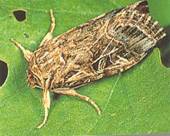Crop Protection :: Cash Crop :: Pest of Cotton
Tobacco Cutworm: Spodoptera litura
|
 |
 |
Symptoms of damage
- Scrapping the epidermal layer, leaving the skeleton of veins of leaf
- During severe attack, only the stem and side shoots will be standing in the field without any leaf or bolls
- Larvae feed the leaves by making small holes
|
|
- Identification of the pest
- Egg - Laid in masses which appear golden brown
- Larva- Pale greenish with dark markings. Gregarious in the early stages
- Adult: Forewings- brown colour with wavy white marking
- Hindwings- white colour with a brown patch along the margin
|
Management
- ETL:8 egg masses/100 m row
- Use of light trap to monitor and kill the attracted adult moths
• Set up the sex pheromone trap at 12/ha to monitor the activity of the pest and to synchronise the pesticide
application, if need be, at the maximum activity stage
• Growing castor along border and irrigation bunds
• Removal and destruction of egg masses in castor and cotton crops
• Removal and destruction of early stage larvae found in clusters that can be located easily even from a distance
• Collection and destruction of shed materials
• Hand picking and destruction of grown up caterpillars
• Spray any one of the following insecticides per ha using a high volume sprayer covering the foliage and soil surface:
• Chlorpyriphos 20 EC 2.0 l
• Chlorpyriphos 20 EC 1.25 l
• Chlorantraniliprole 18.5% SC 150 ml
• Diflubenzuron 25% WP 300-350g
• Spraying nuclear polyhedrosis virus at 1.5 x 1012 POB per ha in evenings.
• Spraying of insecticides should be done either in the early morning or in the evening and virus in the evening.
• Use of poison bait pellets prepared with rice bran 12.5 kg, jaggery 1.25 kg, Carbaryl 50% WP 1.25 kg and water 7.5 litres. This bait can be spread in the fields in the evening hours so that the caterpillars coming out of the soil, feed and get killed.
|
|


